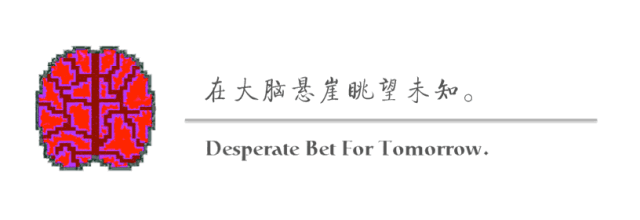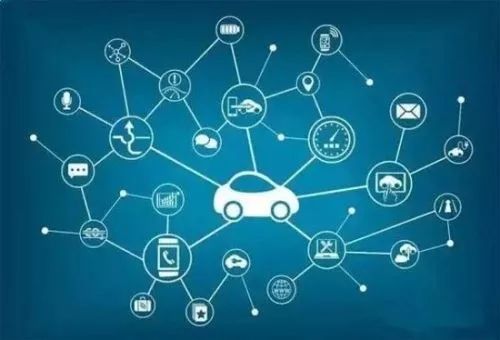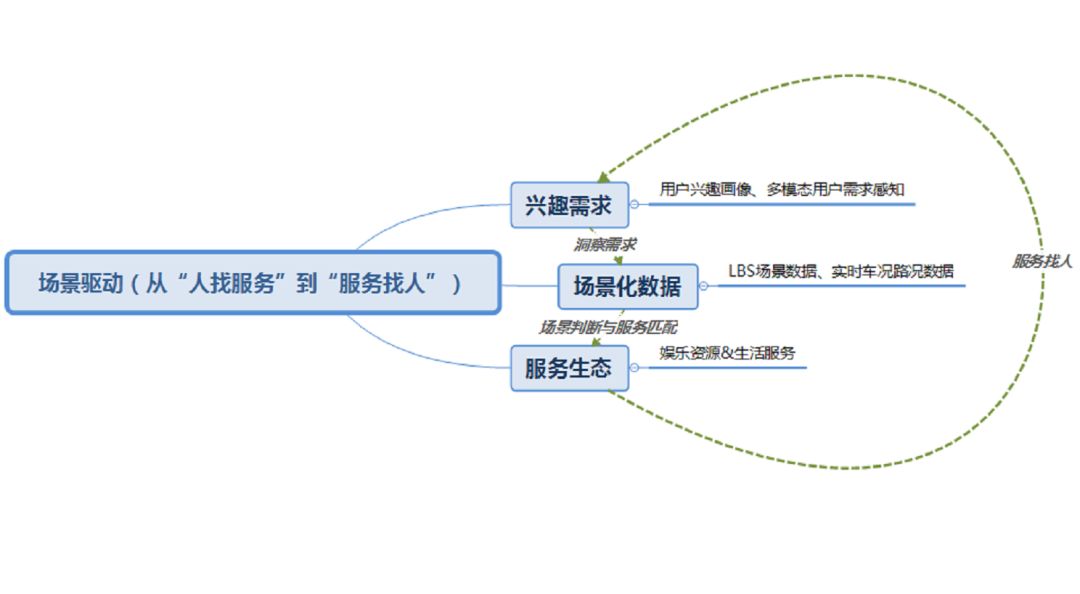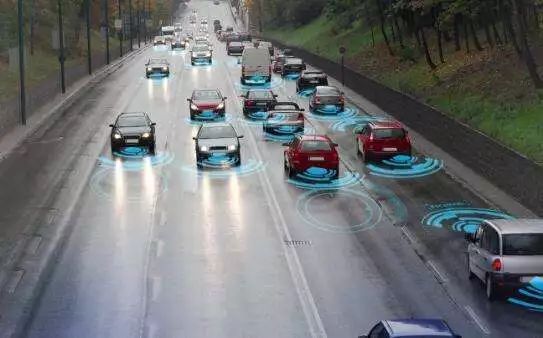

Since the day the term “Internet of Vehicles” was coined, it has been a rather complex concept. Another term for it is V2X (vehicle to X), meaning “from vehicles to everything”.
In the process of connecting vehicles to everything, drivers and passengers have more opportunities for communication with the vehicle. Various needs that may arise in the travel scenario can be satisfied within the automotive context, such as in-car entertainment consumption, destination scene requirements, vehicle refueling and maintenance, etc.
However, in most cases, IoV services merely transplant internet services and products onto the automotive platform. Yet, the relationship between humans and vehicles is showing a trend of constant change.

How will the relationship between humans and vehicles change? And will the way IoV provides services also change accordingly under the evolution of this relationship?
We can try to find answers to these questions from the “Ecological Internet of Vehicles” model proposed by Tencent.
Smart, Proactive, Rich:
The Evolutionary Trajectory of Future Human-Vehicle Interaction
With the widespread application of new technologies such as AI and 5G, we are in an era of rapid change, and the relationship between humans and vehicles is continuously evolving.
Firstly, the development of basic sciences has accelerated the pace of our lives, prompting us to seek maximum service with minimal human-machine interaction. The leap from physical interaction to voice interaction is a typical example. We are beginning to reject the distance from hand to screen, opting instead for more natural voice communication with devices. This pursuit of simpler interaction will also extend into travel scenarios.
In addition to changes in interaction, the way people access services is gradually shifting from active to passive. Based on the mining of massive data, service providers can gain deep insights into user needs and interests, enabling efficient matching of user demands with their services in an intelligent way. This efficient matching can occur in any scenario, including travel.

From a long-term perspective, although autonomous driving cannot be widely adopted in the mass market in the short term, as technology continues to develop, there will inevitably be a process of “assisted driving – partial road autonomous driving – autonomous driving.” The liberation of drivers’ time and energy is a trend that is becoming increasingly inevitable. At this point, the service ecosystem provided inside the vehicle should naturally become richer.
In summary, the future of IoV will exhibit three trends: smarter, more proactive, and richer. Meanwhile, the model of transplanting mobile phone service ecosystems into automotive scenarios does not align with the evolutionary trajectory of human-vehicle interaction. Compared to mobile phones, the personal attribute of automotive spaces is weaker, and people’s demands for software services in this context will be more specialized and personalized. The IoV services we will need in the future will obviously need to be optimized for automotive scenarios and human-vehicle interaction, building on previous internet services.
All of this aligns with Tencent’s definition of the ecological IoV.
Three Lives and Everything About Future Driving:
Tencent’s Three Major Ecosystems in Vehicles
From Tencent’s perspective on building the ecological IoV, their solution introduces three major ecosystems: interest content ecosystem, vehicle owner service ecosystem, and lightweight application ecosystem.

In the evolution of the ecological IoV, these three ecosystems may play an important role in the concept of “three lives and everything”.
First, regarding the interest content ecosystem, although it is currently difficult to form a strong correlation with interest content in travel scenarios, the ability to gain insights into user interests is closely related to the user’s travel experience.
For instance, when a user drives to a certain commercial area, whether the ecological IoV can sense the user’s interests and recommend their favorite restaurants or suggest a song they like based on the current weather is a test of the depth of the interest content ecosystem.
As for the vehicle owner service ecosystem, it determines whether the ecological IoV can establish connections between the vehicle itself and external services, building a service ecosystem that spans pre-, mid-, and post-vehicle usage under the same account. Compared to users themselves, the ecological IoV should be able to detect vehicle scenario data earlier. If it can utilize vehicle scenario data and flexibly match with vehicle owner services, it can alleviate the entire process for drivers from discovering needs to seeking services.
Take the simple matter of refueling as an example: rather than the driver discovering that the vehicle is low on fuel, planning a route to find a gas station, and then recalculating the route to the original destination, the ecological IoV can proactively detect the need for refueling and provide reminders as the driver passes a gas station, which is evidently a more efficient and seamless service experience.
Alongside these two, the lightweight application ecosystem optimizes service experience details through rich intelligent tools. Through lightweight applications, functionalities such as voice interaction and mobile payments, originally found on mobile devices, can be developed in the automotive context. Tencent’s IoV introduces millions of mini-programs that allow users to interact based on geographic fencing, vehicle scenario data, and their own needs without the need for downloads or wake-ups.
As previously mentioned, proactively recommending dining destinations and finding gas stations, within the lightweight application ecosystem, booking restaurants and paying for gas can all be done through voice interaction, creating a cohesive interaction experience before, during, and after the journey.
In other words, the future driving experience under the ecological IoV may look like this: when we set our navigation destination, Tencent IoV recommends several popular restaurants based on our preferences, allowing us to reserve a table through voice interaction in the lightweight application; halfway through the drive, Tencent IoV reminds us that the fuel is low and plans the route to the nearest gas station; at the gas station, we can also complete the transaction through voice interaction with voiceprint recognition; upon arrival at the destination, Tencent IoV will notify us how many tables are available at the restaurant and plan the route to the nearest parking lot.
The Path and Everything:
The Logical Deduction Behind the Ecological IoV
This future driving experience of “three lives and everything” is indeed attractive, but it is built upon a complete foundation of technological logic. Just as “the Dao produces one, one produces two, two produces three,” the realization of an ecosystem often comes from layer upon layer of deduction.
To establish the technical logic that supports the ecological IoV, there must be sufficient data, content, and services.
This includes a vast number of user touchpoints to obtain user interest behavior data, a rich software service ecosystem to connect various life and travel service needs for travel destinations, and abundant location-based service (LBS) scenario data to enable the ecological IoV to perceive various services contextually during driving.
These foundational data, content, and services are akin to “the Dao produces one,” laying the groundwork for subsequent technological applications and ecosystem construction.

Built on a rich data foundation, the role of AI technology should be leveraged. For example, utilizing multimodal recognition technologies such as voice recognition, facial recognition, and gesture recognition to sense users, and employing AI algorithms to mine data for precise matching of user interest demands with ecological services.
Based on the data foundation, this process of utilizing AI technology to move from sensing users to matching services achieves “one produces two”.
Lastly, and most importantly, Tencent’s own “super ID” helps connect data and services between automotive terminals and mobile internet terminals through platform account advantages, ensuring that the travel scene is no longer isolated. Whether it’s interest mining or life service provision, it connects with users’ daily lives.
With the platform account as the connecting hub, the interest content, vehicle owner services, and lightweight applications can successfully take root in the automotive context, evolving from “two produces three” to “three produces everything”.
For instance, the Wutong Vehicle Network, jointly established by Tencent and Changan, has launched the TINNOVE automotive intelligent system, which deeply integrates Tencent’s foundational capabilities and core ecological resources to provide users with personalized service recommendations based on scenarios, constructing a comprehensive intelligent travel scene service solution. Currently, the TINNOVE automotive intelligent system supports over 40 refined service scenarios, including car washes, refueling, maintenance, traffic violation queries, mini-games, and food recommendations. This represents the complete process from “the Dao” to “everything”.
We can also see that although the final result presented to users is a shift from “people finding services” to “services finding people,” the foundational technology logic building behind the ecological IoV is like a frozen three feet, requiring continuous construction from the mobile internet era to the AI era. Thus, we can discover that the biggest difference between Tencent’s proposed ecological IoV and traditional IoV is that it views the vehicle as one of several intelligent terminals, interconnected with other smart terminals such as mobile phones, integrating the vehicle into the digital ecosystem through a user-centric account system, big data, and AI technology.

Tencent’s proposal for this ecosystem clearly points to the future division of labor in the travel industry— the development from mobile internet to IoV is not a complete overhaul, but rather a gradual parallel transplantation of capabilities by companies like Tencent, which have accumulated sufficient technological experience and resources in the mobile internet era, into automotive contexts, empowering through collaboration with automotive manufacturers to promote the growth of ecological IoV.
Perhaps in the future outlined by Tencent’s ecological IoV, the “vehicle” will no longer be the core of the IoV; instead, the vehicle will become one among countless digital life scenarios, just like family and office scenes, while the “human” as the user will be the ultimate direction of all services.



